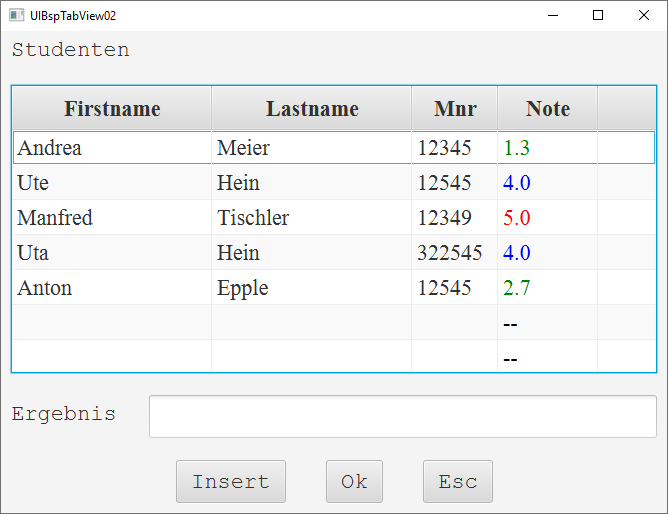
Return in TabContext, _tabIndex is initiallised as 0, everything is ok, if it is 1 or 2, the content from the tabs is drawn too high (the yellow and the blue square starts at the same level as the top of the tab-label, while it should start at the bottom of it). tMainQmlFile(QStringLiteral("qml/test/main.qml"))
#Tabview qml code
Add the code from the example History.qml file to your History.qml file to access the code model. Copy the implementation from HistoryTableView.qml. Viewer.rootContext()->setContextProperty(QString("tabContext"), &context) In the Projects view, right-click qml.qrc and select Add New > Qt > QML File (Qt Quick 2) to create the HistoryTableView.qml file and to add it to the project. #pragma warning(pop) #include "TabContext.h" Int "TabContext.h" TabContext::TabContext(void)

Q_PROPERTY(int tabIndex READ getTabIndex WRITE setTabIndex NOTIFY tabIndexChanged) #define TABCONTEXT_H #pragma warning(push, 0) I've got a more simple case which shows the QtQuick 2.0 When this is shown on screen, i get the wrong behaviour of the tabs. Qproperty in the stored state in the statemachine). When I pop this state (the 'tabview' state is stored in the statemachine), again theĪctiveStateQmlLocationChanged signal is emitted, so the qml file OperatorMain.qml is loaded (with the currentIndex bound to the The new qml file (belonging to the new state). When the state changes, the stateMachineQMLInterface.activeStateQmlLocationChanged signal is emitted, so the loader loads Q_PROPERTY(int currentTabIndex READ getCurrentTabIndex WRITE setCurrentTabIndex NOTIFY implements the methods for getLocationOfQmlFile and registers it's contextProperty to the viewers rootContext)

Source: AMSOperatorMainStateQMLInterface : public AMSIStateQMLInterface Source: operatorSystemMonitoringStateQMLInterface.getLocationOfQmlFile() Source: operatorJobManagementStateQMLInterface.getLocationOfQmlFile() Source: stateMachineQMLInterface.activeStateQmlLocation Īnchors.fill: (source file for the 'tabview' parent ĬurrentIndex: operatorMainStateQMLInterface.currentTabIndex Also the border is drawn to high.Īnyone has an idea what is wrong? (If i don't bind the currentIndex property, the first tab is active and it's content is shown correct (anchored to the bottom of the tab)) This seems to work, except that the rendering of the tabview is kinda messed up after I switch back: the third tab is shown as the active tab, but it seems like the content of this tab is moved up until the top anchor point of the tab(instead of the bottom anchor point). I did this by binding the currentIndex of the TabView component to a variable in my state object (which is a QObject). When I switch back from this new state to the tabview state, I want my tabview to have the third tab active. From the 3rd tab I can switch to a new state and from this state I can switch back to the 'tabview' state. One of the states is a TabView with 3 tabs. So my role names would be Name, Unit and Value.In my application i have a main.qml file which has a loader which loads the content on the screen dependent on which state the application is in. * columns as well (use ZCOUNT as always last member). * enumeration class providing the columns and the amount of It does work, but now, for some reason, after the dataChanged is emited inside the actual setData override, the cell on QML side does not Thanks for clarification, this gets complicated. Return setData(index(row, column), value) Īnd I call it like this on QML side: onEditingFinished: It is needed whenever a QModelIndex isīool CVarTableModel::setData(const int row, const int column, const QVariant& value) * wrapper for actual \ref setData method subclassed from So far I have utilized the following hack: I added a setData overload method: /** TableModel.roleName = text // or model.roleName = text Your answer is similar to this: But I simply cannot get ahead of it without an example. I would appreciate all Hi, thanks for answer.
#Tabview qml how to
I also dont know how to force the QML TreeView to call the C++ headerData method, but this is of less importance than setData. SourceComponent: visible ? theInputComp : undefined This is my QML test component: import QtQuick 2.12ĬlosePolicy: Popup.CloseOnEscape | Popup.CloseOnPressOutside I would appreciate all help regarding this issue. I think there should be a method to call it indirectly from QML, but I dont know how. I dont know how to create one one the QML side. I could call it by hand, but the problem is that it requires a valid QModelIndex object: bool setData(const QModelIndex &index, const QVariant &value, int role = Qt::EditRole) override Now, I am editing the cells on the QML side and after I am done, I dont know how to make the TreeView call the setData method.

As for now, I have the TableView reading the data correctly using the data method on C++ side. On the QML side, I have a TableView component. I have a custom model class subclassing the QAbstractTableModel.


 0 kommentar(er)
0 kommentar(er)
